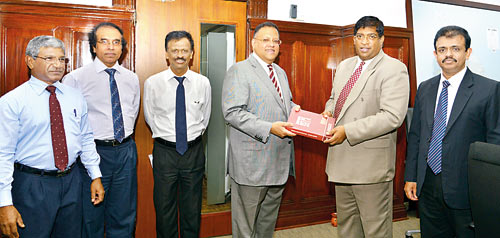Sri Lanka’s GDP growth of 7.4% at 2014, below 7.8 % target, CB says
View(s):Sri Lanka’s economy grew by 7.4 per cent last year, down from the projected 7.8 per cent but higher than 7.2 per cent recorded in 2013, according to the Central Bank’s (CB) annual report for 2014.
(The full report can be seen on http://www.sundaytimes.lk/150503/)

Picture shows the report being handed over in the presence of Deputy Governors - B.D.W.A. Silva and P. Samarasiri, Assistant Governor C.P.A. Karunatilake and acting Economic Research Director D. Kumaratunge.
The report, presented to Finance Minister Ravi Karunanayake by CB Governor Arjuna Mahendran on Wednesday, said that amidst uneven developments in the global economy, continued domestic economic activity helped sustain growth in the industry and services sectors, while adverse weather conditions dampened the performance of the agriculture sector during the year.
GDP per capita (income) increased to US$ 3,625 in 2014 from $3,280 in the previous year.
Inflation remained at single digit levels for the sixth consecutive year, with year-on-year and annual average inflation declining to 2.1 per cent and 3.3 per cent, respectively, by end 2014, from 4.7 per cent and 6.9 per cent, respectively, at the end 2013, the report said.
“Prudent monetary policy as well as the considerable decline in global commodity prices in the second half of the year enabled the deceleration of inflation to low single digit levels during the year,” it said.
In nominal terms, the trade deficit increased to $8.3 billion in 2014 from $7.6 billion in the previous year, as a result of a higher increase in the expenditure on imports compared to the increase in earnings from exports.
“Addressing investment needs in economic and social infrastructure to facilitate sustained economic growth in post-conflict Sri Lanka continued to be a key priority in the government’s development agenda. Several key infrastructure projects were completed during 2014. The construction work relating to a number of other mega infrastructure projects progressed during 2014. Meanwhile, several small scale rural road improvement programmes, irrigation projects, water supply projects, rural electrification projects, housing development programmes and city beautification projects continued during the year. Public investment on economic and social infrastructure development amounted to Rs. 442.4 billion (4.5 per cent of GDP) in 2014. The new government formed in January 2015, is in the process of reviewing the ongoing and proposed mega infrastructure projects to ensure their financial viability, environmental feasibility, equitability, and their overall contribution to the economy,” the report said.
On social indicators and taking the health sector in particular, the report said that in 2014, the number of persons per doctor in the public health service was 1,155 compared to 1,167 in the previous year while the number of hospital beds available per 1,000 persons was 3.7 in 2014 compared to 3.6 in 2013. Government expenditure on education as a percentage of GDP was 1.9 per cent.
The school density in terms of the area covered by a school remained unchanged at 6.5 sq. km, while the student teacher ratio in the government education service also remained unchanged at 18.
“It must, however, be noted that the private sector involvement in the provision of these services has increased considerably in recent years, supplementing the services provided by the public sector. The level of electrification in the country improved further to 98 per cent in 2014 from 96 per cent recorded in 2013,” the report added.
The country’s telephone penetration including cellular phones continued to improve to 120 connections per 100 persons in 2014 from 112.4 in 2013. In terms of poverty indicators, as per the HIES, the poverty head count ratio
(PHCR) in 2012/13 was 6.7 per cent compared to 8.9 per cent recorded in 2009/10. Many of these indicators stand well above the levels reported by peer economies, although continued efforts are necessary to fill the remaining gaps in economic and social infrastructure provision.


